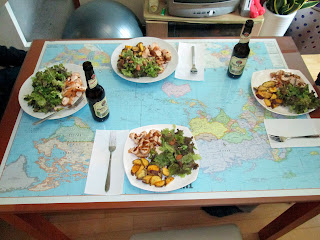In the mid 7th century Buddhist monks built what what today is perhaps the most famous temple in Korea: Beomeosa Temple. The temple itself is actually a set of several large compounds of small temples built far into the wilderness against a wall a mountains. The buildings have been burned and reconstructed several times in their 1300 years lives, the most recent reconstruction dating back to the early 17th century.
The general disposition of the temple buildings: a set of buildings surrounding an open pavilion with stone statues.
A view of the roofs from one compound.
When we first arrived at the temple site, it took us about an hour before we actually made our way inside the walls of the compounds. Surrounding the walls are numerous trails lined with bamboo shoots. To say the least, it is stunning. The trees have wept most of their yellow and brown leaves to the forest floor. Their branches are naked and stark against the grey sky. The brown and yellow brown lays undisturbed, solitary, and somehow rich. It was a strange contrast, beneath our feet, above our eyes.
So we spent our first hour wandering among the scenery, as one might become reacquainted with an old friend.
The trees adorned themselves with many vines.
A 200-year-old bridge over the memory of a river.
As Natalie said when she saw it, "My tree throne!"
The above picture seems to be the remains of what was probably a very large river. Judging by the size of the trees, it hasn't flowed in some time. The rock bed itself is probably 100 meters wide, moves up into the mountains towards their peeks, and flows down hill beyond site. Their was a sign at the edge of the rock bed, but it was written in Korean. Which naturally was an insurmountable hurdle to our greater understanding of the river.
This tree was enclosed in a small rock wall, and was very large, very beautiful. The 4 nests in upper reaches of its branches suggest that the birds agreed. In the background is a nice representation of the kinds of mountains surrounding the temple.

After exploring Beomeosa's surroundings we wandered inside the expanse of the Temple compounds. The architecture was rich, colorful, serene. There were many buildings, each with their own purpose and unique design. The grounds were quiet, with a few other spectators meandering from room to room. What is perhaps the single coolest thing about the temple is that most people visiting the temple were Buddhists who were coming to pay homage and pray. Secondly, the temple grounds are kept by Buddhist monks who live at the Temple permanently. Thus, it felt unlike an historical tourist attraction (i.e. Notredame), and rather was a place whose 1300 year history has gone relatively unchanged in time - that is, barring the modern "improvements" of microphones, electric generators, and various cords, all upon which obvious efforts had gone to conceal their conspicuousness.


The above picture to the right is one example of what most of the rooms looked like. Centered was usually a gold colored statue, varying from large to small. Along ever wall, and surrounding the room, you can just barely see, are small square tablets with prayers on them. This particular room harbored 2,500 of the little prayers. Most rooms had the small prayers, and contained about the same number. One large room (below), contained over 12,000, and each tablet with its own personal electric candle. Unfotunately, cameras were not allowed inside the rooms. Plus, it somehow would seem wrong to take one in anyway.
It was probably one of the most fun trips we have been on since coming to Korea. Next week we will visit again and finish exploring the grounds, and afterward will hike some of the surrounding mountains.
















































